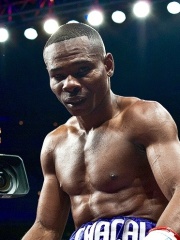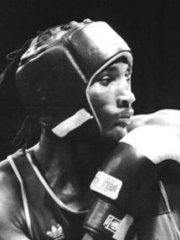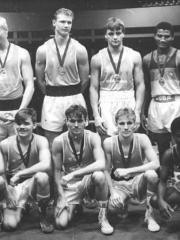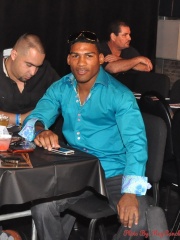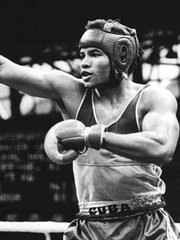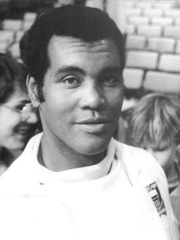
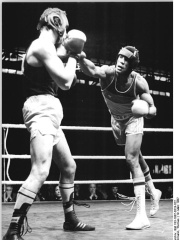
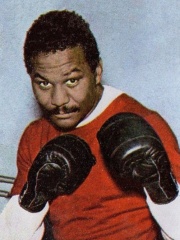

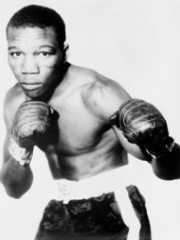

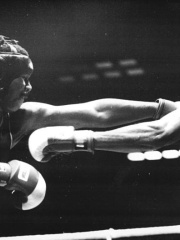
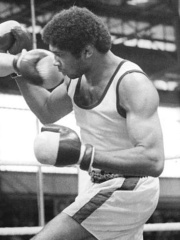
The Most Famous
BOXERS from Cuba
This page contains a list of the greatest Cuban Boxers. The pantheon dataset contains 496 Boxers, 39 of which were born in Cuba. This makes Cuba the birth place of the 3rd most number of Boxers behind United States, and United Kingdom.
Top 10
The following people are considered by Pantheon to be the top 10 most legendary Cuban Boxers of all time. This list of famous Cuban Boxers is sorted by HPI (Historical Popularity Index), a metric that aggregates information on a biography's online popularity. Visit the rankings page to view the entire list of Cuban Boxers.

1. Teófilo Stevenson (1952 - 2012)
With an HPI of 66.63, Teófilo Stevenson is the most famous Cuban Boxer. His biography has been translated into 43 different languages on wikipedia.
Teófilo Stevenson Lawrence (Spanish pronunciation: [teˈofilo steˈβenson]; 29 March 1952 – 11 June 2012) was a Cuban amateur boxer who competed from 1966 to 1986. Stevenson won the Val Barker Trophy (1972) as well was honored with the Olympic Order (1987) and is one of only three boxers to win three Olympic gold medals – alongside the Hungarian László Papp and the fellow Cuban Félix Savón.

2. Félix Savón (b. 1967)
With an HPI of 58.54, Félix Savón is the 2nd most famous Cuban Boxer. His biography has been translated into 29 different languages.
Félix Savón Fabre (born 22 September 1967) is a Cuban former amateur boxer who competed from 1980 to 2000. Considered one of the all-time greatest amateurs, he became three-time Olympic gold medalist, and the World Champion six times in a row, all in the heavyweight division. In 1988, when he was favored by many to win the gold medal at the 1988 Summer Olympics, the Cuban government boycotted the event. Savón is particularly known for having rejected numerous multimillion-dollar offers to defect and leave Cuba permanently to fight Mike Tyson as a professional.

3. José Nápoles (1940 - 2019)
With an HPI of 57.86, José Nápoles is the 3rd most famous Cuban Boxer. His biography has been translated into 16 different languages.
José Ángel Nápoles (April 13, 1940 – August 16, 2019) was a Cuban-born Mexican professional boxer. He was a two-time undisputed welterweight champion, having held the WBA, WBC, and The Ring welterweight titles between 1969 and 1975. He is frequently ranked as one of the greatest fighters of all time in that division and is a member of the International Boxing Hall of Fame. His record of the most wins in unified championship bouts in boxing history, shared with Muhammad Ali, was unbeaten for 40 years. After debuting professionally in Cuba, he fought out of Mexico and became a Mexican citizen.

4. Orlando Martínez (1944 - 2021)
With an HPI of 55.81, Orlando Martínez is the 4th most famous Cuban Boxer. His biography has been translated into 17 different languages.
Orlando Martínez Romero (2 September 1944 – 22 September 2021) was a Cuban bantamweight boxer, who won the gold medal at the 1972 Summer Olympics. Three years later he captured the gold at the 1975 Pan American Games. Orlando was awarded a hotly disputed 3–2 split decision over Great Britain's George Turpin in the 1972 Munich Olympics semifinal before coasting to a comfortable points win over future professional world bantamweight champion Alfonso Zamora in the final to win the division's gold medal.

5. Emilio Correa (1953 - 2024)
With an HPI of 55.54, Emilio Correa is the 5th most famous Cuban Boxer. His biography has been translated into 18 different languages.
Emilio Correa Vaillant (21 March 1953 – 11 March 2024) was a Cuban amateur boxer who won welterweight gold at the 1972 Summer Olympics held in Munich, West Germany. He is not to be confused with his middleweight namesake, who is actually his son. Inspired by his compatriots Roberto Caminero "Chocolatico" Pérez, Enrique Regüeiferos, Félix Betancourt, and Rolando Garbey who also hail from Santiago de Cuba, he started boxing in 1966. At the PanAm Games in Cali, Colombia (1971) he won gold against American Larry Carlisle, but it was not until he beat Betancourt at the national championships in 1972 that he was able to secure his ticket to the Olympics. There he knocked out the defending champion Manfred Wolke of East Germany in the round of sixteen and defeated the rest on points to win Cuba's first welterweight boxing gold. Correa died on 11 March 2024, at the age of 70.

6. Benny Paret (1937 - 1962)
With an HPI of 53.07, Benny Paret is the 6th most famous Cuban Boxer. His biography has been translated into 16 different languages.
Bernardo Paret (March 14, 1937 – April 3, 1962), known as Benny Paret or Benny "Kid" Paret, was a Cuban welterweight boxer who won the Undisputed World Welterweight Championship twice in the early 1960s. Paret's death occurred 10 days after injuries sustained in a March 24, 1962, title defense against Emile Griffith, televised live and seen by millions on ABC's Fight of the Week. Paret had a lifetime record of 35 wins (10 knockouts), 12 losses and 3 draws.

7. José Gómez Mustelier (b. 1959)
With an HPI of 52.46, José Gómez Mustelier is the 7th most famous Cuban Boxer. His biography has been translated into 18 different languages.
José Gómez Mustelier a.k.a. Jovani Gomez (born January 28, 1959, in Colombia, Cuba) is a retired Cuban boxer, who won the middleweight gold medal at the 1980 Summer Olympics. In the final he defeated Viktor Savchenko of the USSR on points (4–1). Two years earlier he captured the world title at the second World Championships in Belgrade, followed by the gold medal at the 1979 Pan American Games.

8. Roberto Balado (1969 - 1994)
With an HPI of 50.86, Roberto Balado is the 8th most famous Cuban Boxer. His biography has been translated into 22 different languages.
Roberto Balado Méndez (15 February 1969 – 2 July 1994) was a Cuban amateur boxer, who competed from 1986 to 1994. At the 1992 Summer Olympics he won a Gold medal in the men's super heavyweight (+91 kg). A natural heavyweight, he was Olympic champion (Barcelona 1992), three times world champion (Moscow 1989, Sydney 1991, and Tampere 1993), and five times Cuban national champion. He was also the winner of the Val Barker Trophy for Outstanding Boxer at the 1992 Olympic Games. Balado was at his prime, looking forward to win many forthcoming events, considered by some boxing experts to be the world's second-best fighter after Félix Savón (who competed one weight division below), and being one of the favourites of the 1995 Pan American Games and 1996 Olympics, but died in a car accident. At the time of his death, age 25, he had 250 fights, with a record of 238 victories, and 12 losses.

9. Armando Martínez (b. 1961)
With an HPI of 49.89, Armando Martínez is the 9th most famous Cuban Boxer. His biography has been translated into 15 different languages.
Armando Martínez Limendu (born 29 August 1961) is a Cuban boxer. At 18 years of age he won the gold medal in the Light Middleweight (71 kg) category at the 1980 Summer Olympics, beating Aleksandr Koshkyn in the final. In 1982 he won the silver medal at the World Championships in Munich, West Germany, this time losing to Koshkyn. He had previously won a silver medal at the 1978 World Championships.
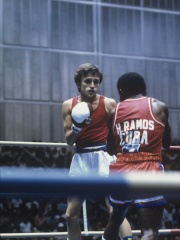
10. Hipólito Ramos (b. 1956)
With an HPI of 49.26, Hipólito Ramos is the 10th most famous Cuban Boxer. His biography has been translated into 17 different languages.
Hipólito Ramos Martínez (born January 30, 1956) is a retired boxer from Cuba, who won the silver medal in the Light Flyweight division (-48 kg) at the 1980 Summer Olympics in Moscow. In the final he lost to Shamil Sabirov of the Soviet Union on points (2-3).
People
Pantheon has 39 people classified as Cuban boxers born between 1937 and 2000. Of these 39, 30 (76.92%) of them are still alive today. The most famous living Cuban boxers include Félix Savón, José Gómez Mustelier, and Armando Martínez. The most famous deceased Cuban boxers include Teófilo Stevenson, José Nápoles, and Orlando Martínez. As of April 2024, 5 new Cuban boxers have been added to Pantheon including Angel Espinosa, Juan Hernández Sierra, and Diógenes Luna.
Living Cuban Boxers
Go to all RankingsFélix Savón
1967 - Present
HPI: 58.54
José Gómez Mustelier
1959 - Present
HPI: 52.46
Armando Martínez
1961 - Present
HPI: 49.89
Hipólito Ramos
1956 - Present
HPI: 49.26
Andrés Aldama
1956 - Present
HPI: 48.47
Guillermo Rigondeaux
1980 - Present
HPI: 48.45
Jorge Gutiérrez
1975 - Present
HPI: 46.94
Juan Carlos Lemus
1966 - Present
HPI: 46.48
Rogelio Marcelo
1965 - Present
HPI: 45.97
Mario Kindelán
1971 - Present
HPI: 45.51
Odlanier Solís
1980 - Present
HPI: 45.12
Yuriorkis Gamboa
1981 - Present
HPI: 44.58
Deceased Cuban Boxers
Go to all RankingsTeófilo Stevenson
1952 - 2012
HPI: 66.63
José Nápoles
1940 - 2019
HPI: 57.86
Orlando Martínez
1944 - 2021
HPI: 55.81
Emilio Correa
1953 - 2024
HPI: 55.54
Benny Paret
1937 - 1962
HPI: 53.07
Roberto Balado
1969 - 1994
HPI: 50.86
Jorge Hernández
1954 - 2019
HPI: 47.06
Angel Espinosa
1966 - 2017
HPI: 44.75
Héctor Vinent
1972 - Present
HPI: 44.55
Newly Added Cuban Boxers (2025)
Go to all RankingsAngel Espinosa
1966 - 2017
HPI: 44.75
Juan Hernández Sierra
1969 - Present
HPI: 44.54
Diógenes Luna
1977 - Present
HPI: 41.28
Yudel Johnson
1981 - Present
HPI: 35.35
Erislandy Álvarez
2000 - Present
HPI: 34.18
Overlapping Lives
Which Boxers were alive at the same time? This visualization shows the lifespans of the 8 most globally memorable Boxers since 1700.


